Healthcare runs on people, and when staffing falters, patient care suffers. A missed shift, a late punch, or an unplanned absence leaves already overworked teams scrambling, which can compromise the quality of bedside care.
Tracking your staff in a care setting is uniquely complex. Nurse managers and administrators have to juggle rotating shifts, credentialing requirements, and strict staffing-to-patient ratios that aren’t flexible when someone calls out. One error in scheduling or timekeeping can cascade into compliance risks, overtime costs, and stressed teams.
Time and attendance software built for healthcare takes the guesswork out of staffing. It ensures the right providers are in the right place at the right time, keeps attendance records airtight for compliance, and gives leaders the visibility they need to make quick adjustments when the unexpected happens.
In this post, we’re taking a look at the nine best time and attendance software for healthcare that will help you drive better patient outcomes, experience fewer payroll errors, and build a stronger, more resilient organization.
Overview of the best time and attendance software for healthcare
Here’s a brief overview of our favorite time and attendance software for healthcare. To learn more about a specific tool, click its link to jump down to our full review.
- Buddy Punch: A flexible, easy-to-use solution ideal for smaller practices like doctor’s offices, dental clinics, therapy practices, and home health providers.
- Vagaro: Built for salons, spas, and wellness centers, but increasingly popular with therapy practices and small healthcare offices that need simple scheduling and attendance tracking.
- Mindbody: A strong fit for wellness-focused healthcare settings such as chiropractic clinics, physical therapy practices, and integrative medicine centers.
- Symplr: Enterprise-grade workforce management software designed for hospitals and large healthcare organizations that require strict compliance and credentialing.
- QGenda: Known for its powerful scheduling and time tracking tools tailored to complex hospital departments and physician groups.
- Inovalon: A healthcare-focused platform that integrates staffing, scheduling, and compliance tools for organizations managing large, distributed teams.
- Oracle: Enterprise workforce management integrated with hospital operations, giving leaders the tools to align staff coverage with patient demand while controlling labor costs.
- Nursegrid: A nurse-built platform that makes scheduling, shift swaps, and credential management simple for care teams and department managers.
- Smartlinx: A long-term care–focused solution that combines scheduling, time tracking, and compliance features to help senior care and post-acute facilities maintain proper staffing and reduce overtime.
What is time and attendance software?
Time and attendance software is a digital system that tracks when employees start and end their shifts, records absences, and keeps a reliable log of who is available at any given time. In healthcare, it’s a safeguard against staffing breakdowns.
Unlike basic time clock apps, healthcare-focused solutions account for rotating schedules, shift swaps, and mandatory staffing ratios. They provide visibility into who’s on the floor, who’s running late, and who might be approaching overtime. They also sync with payroll to reduce errors and help meet labor law requirements.
For smaller practices, this kind of software makes it easier to coordinate front desk staff, nurses, and providers without drowning in paper timesheets or sticky-note schedules. For hospitals and larger organizations, it provides the control and accuracy needed to manage hundreds of staff across multiple departments, all while keeping compliance front and center.
The benefits of time and attendance software in healthcare settings
In healthcare, the benefits of time and attendance software reach far beyond payroll, shaping how well teams deliver care and keep operations running smoothly.
- Stronger patient care through reliable staffing: When the right number of nurses, aides, and specialists are on the floor, patients get better, safer care. Time and attendance software helps prevent gaps by ensuring schedules are covered and alerting managers to potential understaffing before it becomes a crisis.
- Less administrative burden: Manual scheduling and paper timesheets eat up valuable hours that could be spent on patient care. Automating attendance tracking, scheduling, and payroll sync frees managers from chasing down missed punches or correcting overtime errors.
- Reduced payroll errors and compliance risk: From union rules to labor laws to internal policies, healthcare comes with complex requirements. Time and attendance systems automatically calculate overtime, manage break compliance, and provide clean audit trails that protect your organization from disputes and fines.
- Real-time visibility into your workforce: With dashboards and mobile apps, you can see who’s currently clocked in, where coverage might be thin, and whether a shift change is needed. That level of visibility helps managers make quick, informed decisions during busy or unpredictable days.
- Flexibility for staff: Shift swaps, time-off requests, and emergency coverage are part of healthcare. With digital tools, employees can manage these changes from their phones, reducing friction and boosting satisfaction — which helps with retention in an industry already facing high turnover.
Key features to look for in healthcare time and attendance software
The best time and attendance software in healthcare brings together accuracy, visibility, and flexibility so teams can focus on patients instead of paperwork:
- GPS and geofencing: Verify that staff clock in where they’re scheduled to be, whether that’s a hospital unit, a clinic, or a patient’s home. Geofencing prevents off-site clock-ins and ensures coverage is accurate.
- Kiosk and supervisor-led clock-ins: Shared kiosks at nurses’ stations or front desks make it easy for large teams to clock in quickly. Supervisors can manage crew punches for shift changes, saving time and keeping records consistent.
- Smart scheduling tools: Drag-and-drop scheduling, automated shift reminders, and easy shift swaps reduce the headaches of managing complex, rotating healthcare schedules.
- Differential pay and compliance tracking: Healthcare requires accurate overtime, night/weekend/holiday pay, and strict break compliance. Automated rules protect against costly mistakes and help meet labor law and union requirements.
- PTO and availability management: Staff can request time off or mark availability directly in the app. Managers can build schedules knowing who’s available, reducing last-minute scrambles.
- Payroll integrations and reporting: Attendance data should sync directly with payroll providers to cut errors and save time. Customizable reports support billing, compliance audits, and labor cost analysis across departments or patients.
The 9 best time and attendance software for healthcare
Healthcare staffing is too complex for paper timesheets or generic apps. From hospitals balancing strict nurse-to-patient ratios to small practices needing flexible scheduling, the right software helps ensure coverage, prevent payroll errors, and keep patient care the priority.
Below, you’ll find nine of the best time and attendance tools for healthcare in 2025, with options for organizations of every size.
| Software | Best for | Key strengths | Starting price |
|---|---|---|---|
| Buddy Punch | Independent practices & small healthcare teams | Simple scheduling, GPS/geofencing, PTO tracking, payroll integrations | $4.49/user/month + $19 base fee |
| Vagaro | Spas, salons, and wellness clinics | Appointment scheduling + attendance, staff management, payroll add-ons | $23.99/user/month at a single location |
| Mindbody | Fitness, therapy, and wellness centers | Class & appointment scheduling, staff management, integrated billing | $99/month/location |
| Symplr | Large hospital networks | Workforce compliance, credentialing, scheduling across departments | Custom pricing only |
| QGenda | Physician groups & hospital departments | Automated physician scheduling, on-call management, compensation tracking | Custom pricing only |
| Inovalon | Enterprise healthcare organizations | Advanced workforce analytics, time & attendance compliance | Custom pricing only |
| Oracle | Hospital systems with complex operations | Workforce scheduling tied into clinical operations, analytics | Custom pricing only |
| Nursegrid | Nurses and nurse managers | Nurse-focused scheduling, shift swaps, mobile-first communication | $5/user/month |
| Smartlinx | Long-term care & post-acute facilities | Real-time workforce management, predictive scheduling, compliance | Custom pricing only |
1. Buddy Punch – Best for independent practices & small healthcare teams
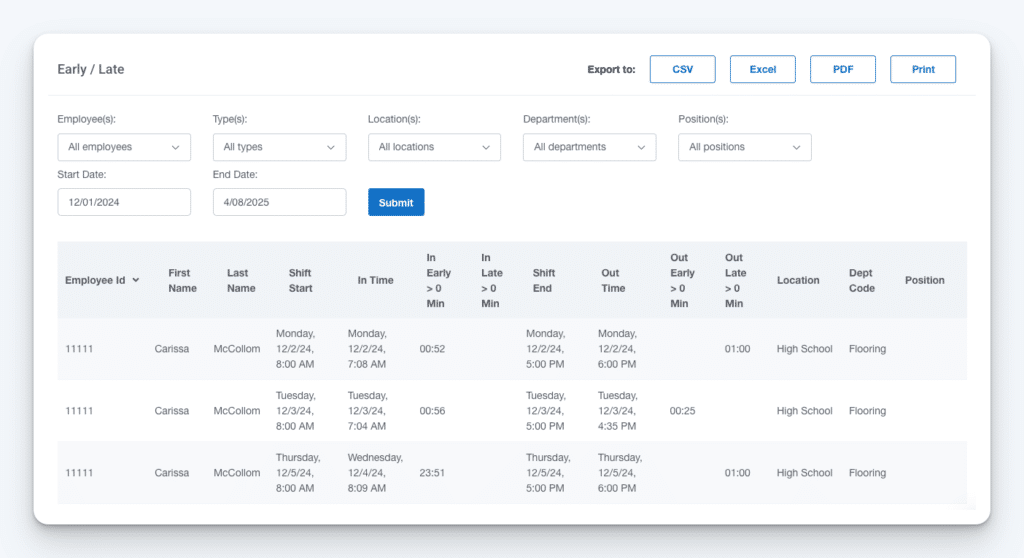
For healthcare teams, a missed punch or unplanned absence can disrupt coverage, overload colleagues, and compromise patient care. Smaller organizations like doctor’s offices, dental practices, therapy clinics, and home healthcare teams often feel this strain most acutely because they don’t have the luxury of deep staffing pools. That’s where Buddy Punch comes in.
Buddy Punch is designed to make workforce management in healthcare as seamless as possible without adding unnecessary complexity. Instead of juggling paper timesheets, Excel schedules, and late-night texts to fill open shifts, administrators get one straightforward platform that handles time tracking, scheduling, attendance, and payroll in real time.
The interface is deliberately clean and mobile-friendly, making it simple for busy staff to clock in, review schedules, and submit requests even during the chaos of a shift handoff or patient call.
Unlike general time and attendance software for small businesses, Buddy Punch adapts to the unique needs of care environments. A charge nurse can clock in an entire unit at once, while therapists or home health aides can punch in from their phones with geofenced verification that ensures hours are tied to the right location or patient visit.
Alerts notify managers when someone is late, approaching overtime, or has missed a shift entirely, helping leaders stay ahead of problems before they impact patient coverage.
For administrators and payroll teams, Buddy Punch takes the manual effort out of workforce management. Hours and overtime are calculated automatically, differential pay can be applied for nights or weekends, and PTO requests flow directly into timesheets once approved.
Data can be sent directly to payroll providers like QuickBooks, ADP, or Paychex — or handled entirely in Buddy Punch’s own payroll system — reducing errors and freeing managers to focus on operations and care quality.
Ultimately, Buddy Punch’s appeal in healthcare comes down to reliability and adoption. In an environment where every minute counts, a time tracking system has to work for frontline staff as well as managers.
With its user-friendly design, strong compliance features, and real-time visibility, Buddy Punch gives small and mid-sized healthcare organizations the control they need to run staffing more smoothly, protect staff from burnout, and keep patient care at the forefront.
Smart scheduling for healthcare teams
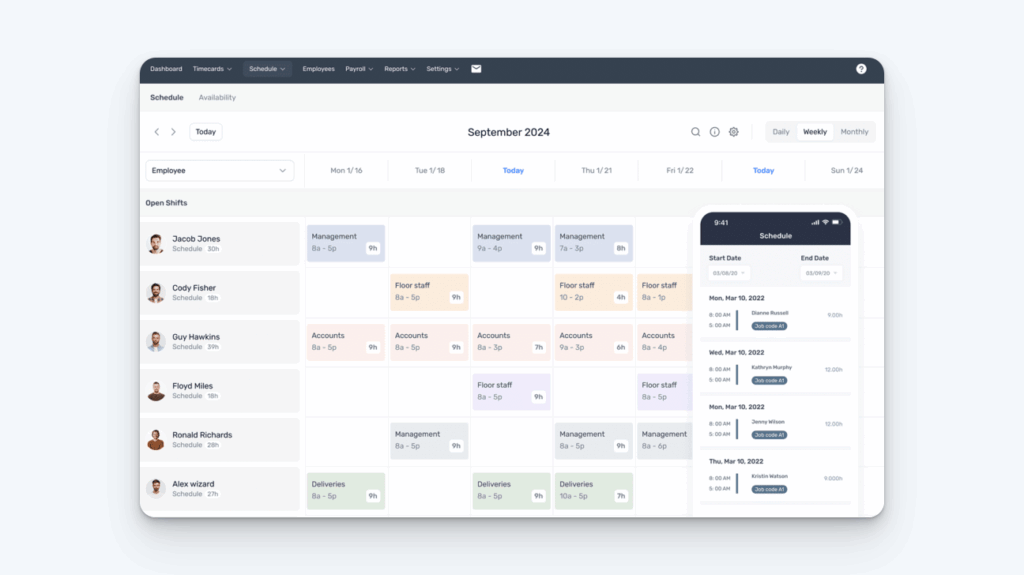
Buddy Punch’s drag-and-drop scheduling tool makes it easy for administrators to build, publish, and adjust schedules in minutes. Staff availability and PTO requests are visible directly in the scheduling dashboard, so you don’t risk assigning someone on their off day.
Nurses and aides can trade shifts or request coverage through the app, while managers stay in full control with approval workflows. For practices with recurring shifts — like weekly therapy appointments or recurring clinic hours — repeating shift templates save hours of scheduling effort.
Accurate time tracking with built-in safeguards
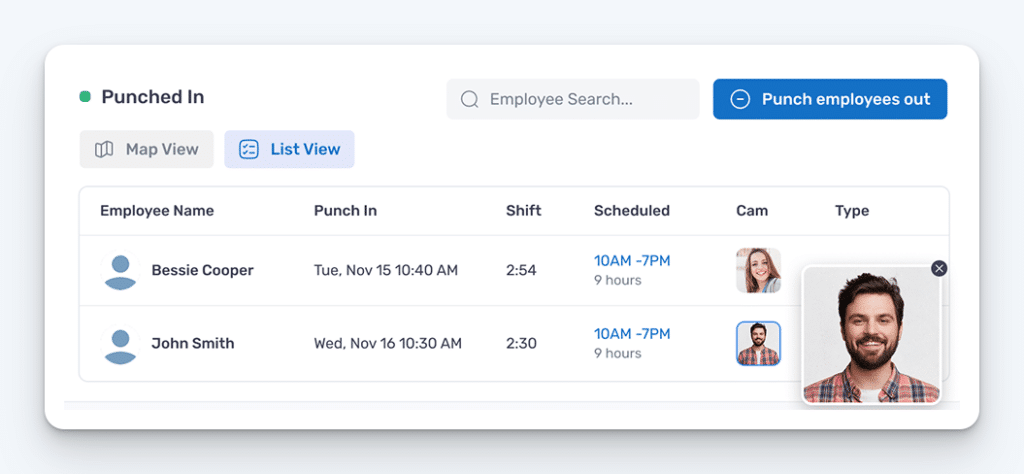
Staff can clock in and out from their phones, computers, or a shared kiosk tablet — whichever fits the practice best. To prevent errors and time theft, Buddy Punch supports photo verification and geofencing, ensuring punches only happen at the correct site.
For salaried roles like office administrators, hours can be entered in bulk instead of tracked minute by minute. Automatic overtime calculations keep everything compliant with labor laws and union rules, while alerts warn managers when staff are approaching overtime thresholds.
Payroll and compliance made simple
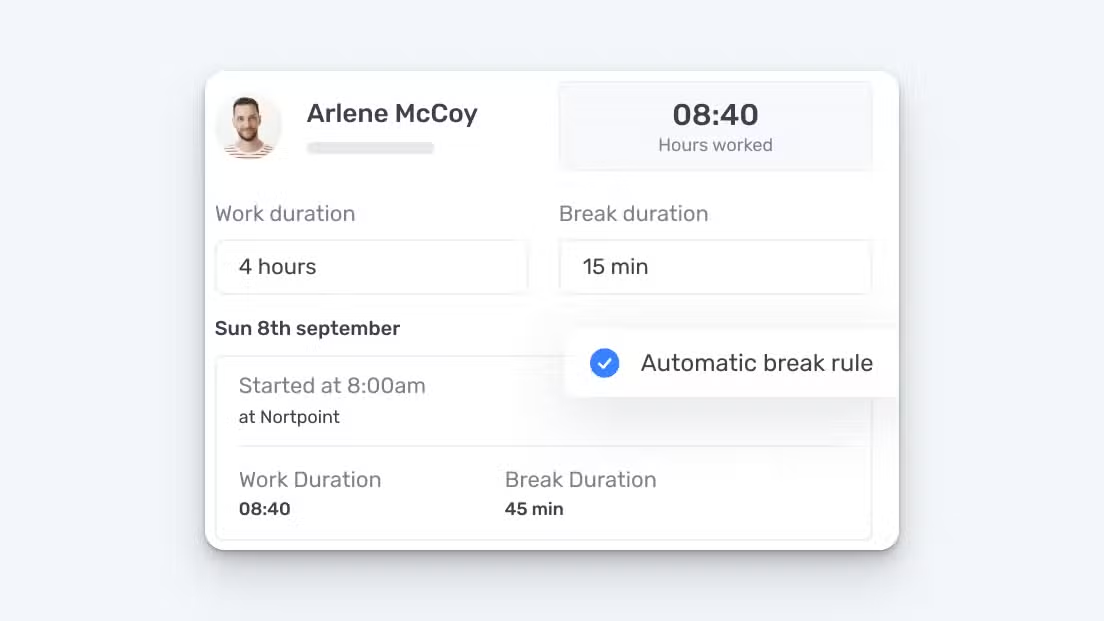
Instead of spending hours reconciling paper timesheets, Buddy Punch automatically compiles all clock-ins, breaks, and PTO into clean digital timesheets. These can be exported directly to payroll providers such as ADP, Paychex, or QuickBooks. Or you can run payroll directly through Buddy Punch.
PTO accruals, differential pay (for nights, weekends, or holidays), and break compliance rules can all be automated, reducing administrative burden and keeping the organization audit-ready.
Real-time alerts and visibility

Healthcare is unpredictable, and staffing needs can change in a heartbeat. Buddy Punch keeps administrators in the loop with alerts for late arrivals, no-shows, or missed shifts. Dashboards provide a live view of who’s currently clocked in across locations, helping managers fill coverage gaps before they affect patient care.
Real-time GPS tools can also be enabled for home healthcare workers, ensuring providers are exactly where they need to be during visits.
Pricing
- Starter — $4.49 per user/month + $19 base fee per month; includes time tracking, PTO tracking, GPS punches, job tracking, payroll integrations, and reporting.
- Pro — $5.99 per user/month + $19 base fee per month; adds scheduling, geofencing, QR code and kiosk punches, and webcam verification.
- Enterprise — $10.99 per user/month + $19 base fee per month; includes everything in Pro plus advanced GPS, API access, SSO, and enterprise-level support.
Learn more about Buddy Punch
- Start a free trial — no credit card required
- View pricing
- Watch a video demo
- Take an interactive product tour
- Request a personalized demo
2. Vagaro – Best for spas, salons, and wellness clinics
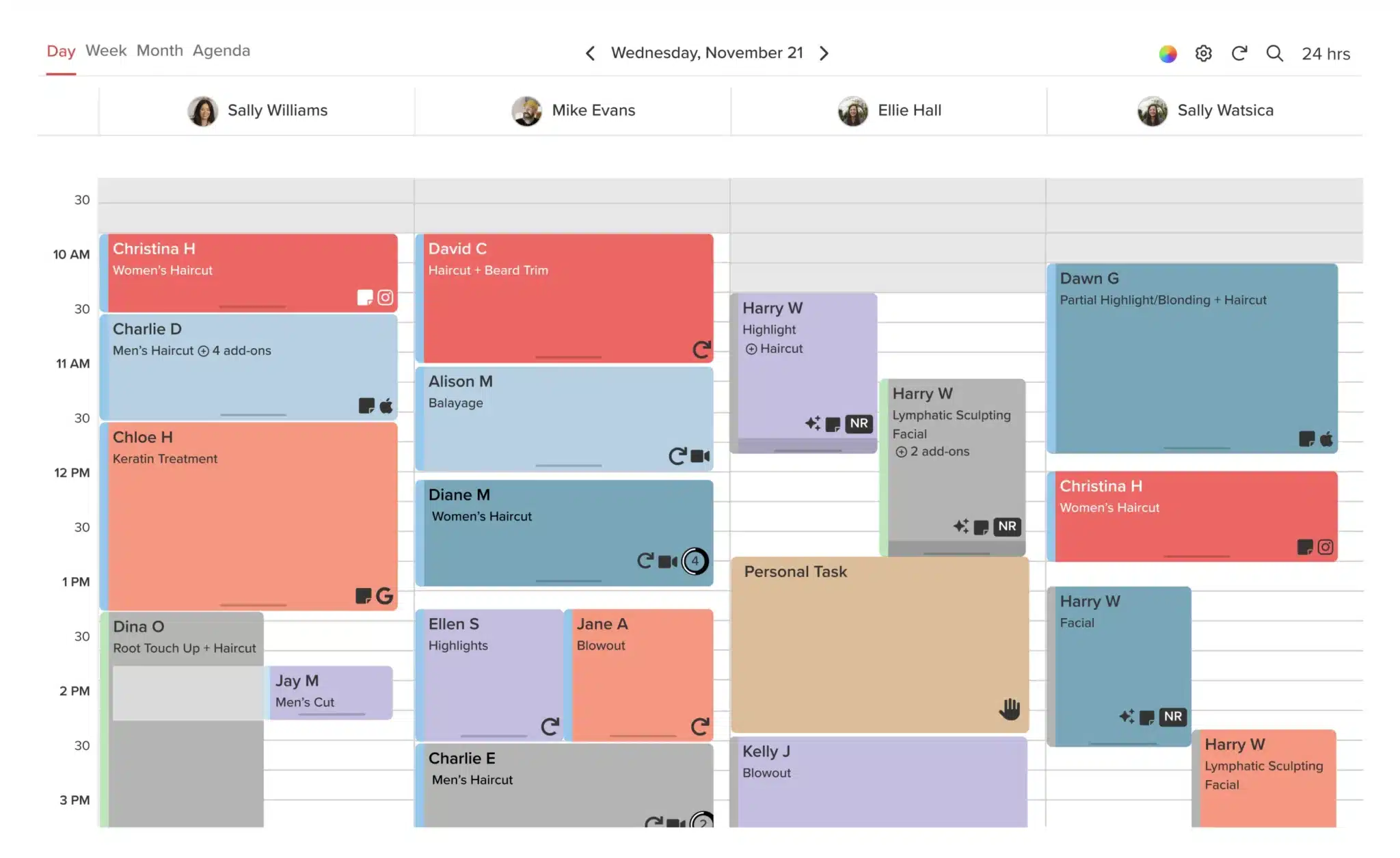
Not every healthcare practice looks like a hospital or large clinic. Chiropractors, physical therapists, acupuncturists, and wellness clinics need the same kind of accountability and scheduling support as larger organizations, but in a way that’s lightweight, affordable, and easy for small teams to adopt.
Originally designed for service-based businesses, Vagaro has built out a strong presence in the wellness and healthcare space. It combines time and attendance tracking with patient scheduling and staff management, giving smaller practices a single platform to manage both the front and back of the house.
For practices that can’t afford to spend hours every week reconciling timesheets or dealing with missed punches, Vagaro’s streamlined tools help administrators keep staff on schedule and payroll accurate.
One of Vagaro’s strengths in healthcare is how seamlessly it ties scheduling and attendance together. Staff can clock in and out directly in the Vagaro system, while managers see real-time updates on attendance and hours worked. Because Vagaro also handles patient bookings, providers’ schedules align automatically with their work hours, reducing the risk of overbooking or payroll errors.
Vagaro is also highly mobile-friendly, which makes it a good fit for practices where staff may float between treatment rooms, front desk, and administrative roles throughout the day. Attendance data flows into detailed reports that can be exported for payroll, while managers can quickly spot attendance issues such as lateness or unapproved absences.
For healthcare practices that also want to manage client appointments, billing, and payroll from one platform, Vagaro’s all-in-one approach is especially appealing. While it may not be built exclusively for medical settings, many independent practices find it a practical, cost-effective solution that keeps both staff and operations running smoothly.
Key features
- Integrated staff scheduling and time tracking — Align staff work hours directly with patient appointments.
- Mobile clock-in/out — Staff can clock in from their phones, ensuring flexibility across treatment rooms or offices.
- Attendance reports — Generate detailed reports on hours worked, overtime, and absences.
- Payroll integration — Export time data to streamline payroll processing.
- All-in-one practice management — Beyond attendance, Vagaro includes tools for booking, billing, and client management.
Pricing
- $23.99/month for one user up to $83.99/month for 7+ users at a single location.
- Multi-location pricing is available by contacting the sales team.
3. Mindbody – Best for fitness, therapy, and wellness centers
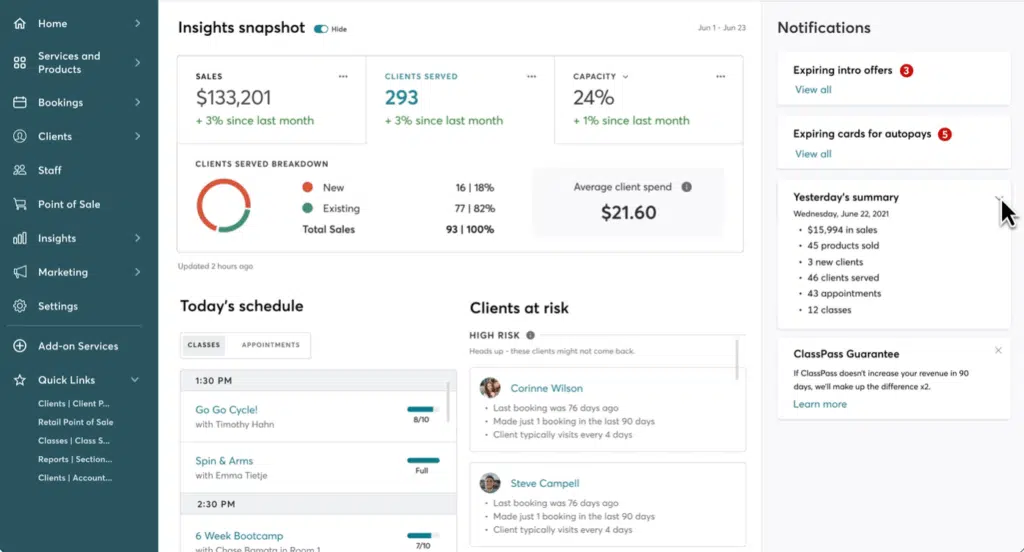
For healthcare organizations that straddle the line between clinical care and wellness services — such as physical therapy practices, chiropractic clinics, integrative medicine centers, or group therapy practices — Mindbody offers an all-in-one solution that covers both patient scheduling and staff time tracking.
Originally built for gyms and wellness businesses, Mindbody has evolved into a powerful practice management platform that smaller healthcare teams increasingly rely on. Its biggest strength lies in combining front-end patient booking with back-end staff management, so the same system that schedules your appointments also keeps accurate records of employee hours and attendance.
Staff can clock in and out directly in the Mindbody platform, whether on a shared kiosk at the front desk or on their phones via the mobile app. Hours flow into detailed attendance and payroll reports, making it easy for administrators to manage overtime, approve timesheets, and push data into payroll processors.
Because the same system also manages your patient calendar, it’s easier to line up staff schedules with demand, ensuring you’re staffed properly for busy days and reducing downtime during slower ones.
Mindbody also caters to staff flexibility and mobility. Employees can swap shifts, update their availability, or request time off within the app. For healthcare managers, this makes last-minute changes easier to handle and helps prevent the frantic texts and calls that often come with manual scheduling.
For practices that need a single system to handle client scheduling, billing, and staff payroll, Mindbody offers a polished, user-friendly option that’s proven in wellness and adaptable to healthcare.
Key features
- Integrated scheduling and time tracking — Sync staff attendance directly with patient appointments.
- Mobile and kiosk clock-in/out — Staff can punch in via mobile app or a shared kiosk at the front desk.
- Attendance reporting — Detailed breakdowns of staff hours, overtime, and absences.
- Shift swapping and time-off requests — Empower staff to manage schedule changes through the app.
- Payroll integrations — Export attendance data directly into payroll systems.
Pricing
- Pricing starts at $99/month per location.
- Exact costs depend on practice size and features, and require contacting sales.
4. Symplr – Best for large hospital networks
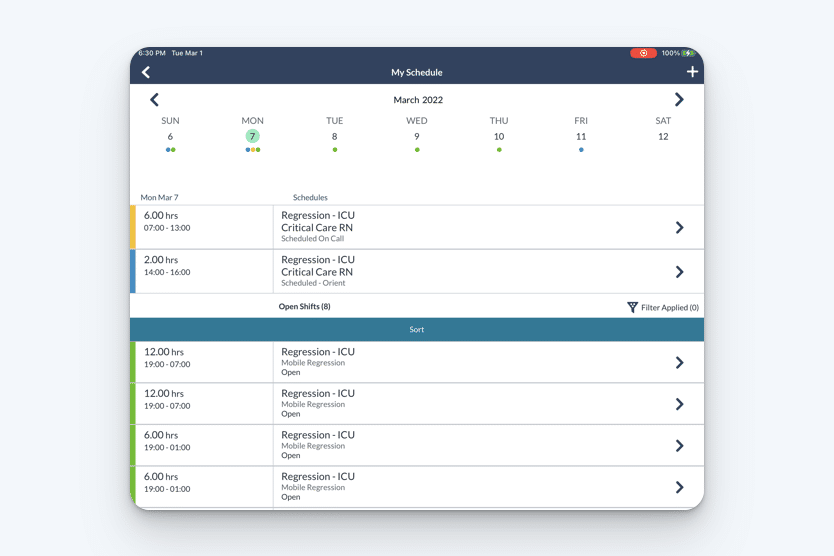
Symplr helps hospitals and large health systems manage labor costs and meet staffing and compliance requirements. Instead of juggling siloed systems for scheduling, payroll, and credentialing, Symplr gives managers and executives a single source of truth. That visibility helps nurse managers, HR teams, and executives align staffing with patient demand while keeping costs under control.
Symplr tracks employee qualifications and union rules to ensure the right people are scheduled for the right shifts, while also monitoring overtime, premium pay, and variances against budget. That level of tracking reduces payroll errors and protects against compliance risks in a heavily regulated industry.
For frontline managers, the Symplr Workforce mobile app makes it practical to oversee scheduling on the go. Staff can swap or request shifts, sign off on timecards, and receive alerts for missed punches or scheduling mismatches.
For healthcare leaders, SymplrAI provides predictive scheduling insights, analyzing patterns and preferences to recommend balanced schedules while still leaving final control in human hands.
Key features
- Healthcare-specific workforce management — Purpose-built for hospitals and large healthcare organizations.
- Compliance support — Tracks labor rules, union agreements, and employee credentials.
- Labor cost control — Identifies and prevents costly overtime and premium pay before it happens.
- SymplrAI scheduling — Provides data-driven recommendations to balance shifts and reduce manager workload.
- Mobile workforce app — Enables staff self-scheduling, shift swaps, timecard sign-offs, and real-time alerts.
- Enterprise-wide visibility — Integrates time, attendance, and scheduling data across clinical and non-clinical roles.
Pricing
- Contact Symplr’s sales team for a tailored quote based on organization size and needs.
5. QGenda – Best for physician groups & hospital departments
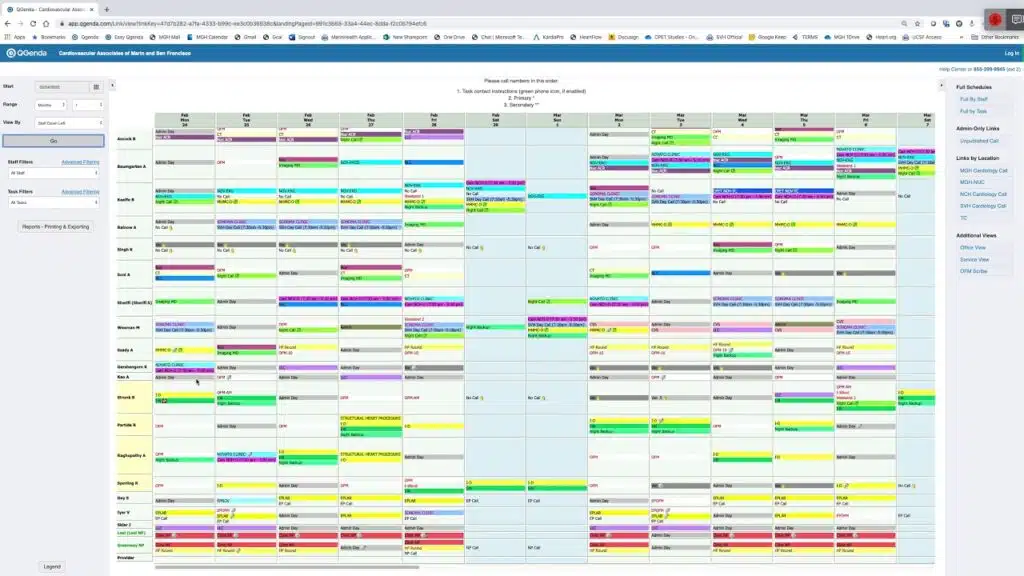
Instead of leaving managers to piece together schedules across different systems, QGenda unifies scheduling and time tracking in one platform. That means every clock-in, every role, and every patient assignment is aligned, so teams can focus less on paperwork and more on care.
Nurses working nights or weekends, physicians on call, float pools covering units in crisis — QGenda applies the right rules automatically and keeps schedules balanced. For frontline staff, that translates into fairer workloads, fewer last-minute changes, and confidence that their time will be tracked and paid correctly.
Managers benefit from real-time visibility into who is working, where coverage may be thin, and when overtime risks could impact both budgets and staff wellbeing. And because it integrates with electronic health records, payroll systems, and clinical communication tools, QGenda eliminates gaps that could delay or compromise patient care.
For hospitals and larger practices juggling dozens of specialties and hundreds of providers, QGenda offers efficiency and peace of mind that your staffing decisions support both your people and your patients.
Key features
- Healthcare-specific workforce scheduling — Designed for physicians, nurses, and support staff across specialties.
- Compliance safeguards — Applies pay rules for overtime, premiums, union agreements, and FLSA automatically.
- Fair and balanced staffing — Creates equitable, rules-based schedules that reduce burnout and improve retention.
- Mobile convenience — Lets staff swap shifts and view schedules or pay details on the go.
- Real-time visibility — Tracks staffing gaps, overtime exposure, and float pool use with enterprise level dashboards.
- System integrations — Connects with EHRs, HRIS, payroll, and clinical communication platforms to keep care aligned.
Pricing
- Contact sales for details.
6. Inovalon – Best for enterprise healthcare organizations
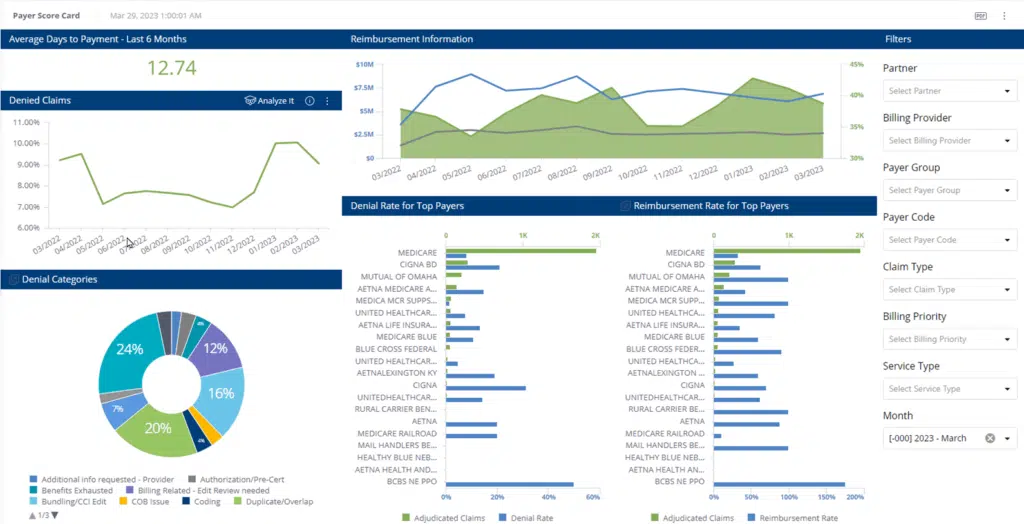
Inovalon links staffing data directly with patient care, compliance, and financial outcomes, making it especially valuable for hospitals, health systems, and larger provider groups.
For frontline managers, this means better visibility into the connection between scheduling and patient safety. If too few licensed staff are on shift, or if overtime is starting to climb, the system flags the risk before it affects care or the margins.
On the operations side, Inovalon automates much of the administrative grind. Staff can clock in from mobile devices or shared kiosks, while managers approve timecards with built-in guardrails for labor law compliance, union agreements, and organizational rules. Exception workflows catch missed punches, meal breaks, or out-of-policy overtime before payroll is finalized.
At the enterprise level, the platform brings together time, attendance, and scheduling data with broader performance indicators. Leaders can run analytics that show, for example, whether premium pay is creeping up in a certain unit, or how staffing variances are affecting readmission rates. This kind of insight helps organizations strike a balance: controlling labor costs while still ensuring the right skill mix at the bedside.
For staff, the experience is straightforward. Mobile apps allow them to view schedules, swap shifts, request time off, and verify hours. Transparency into gross pay calculations reduces disputes and builds trust, while push notifications keep everyone aligned on schedule changes. The result is higher adoption among employees and less time lost to back-and-forth with administrators.
By tying workforce data into the same system that drives clinical quality and financial reporting, Inovalon gives healthcare organizations a holistic approach to improving patient outcomes and strengthening the business.
Key features
- Staffing aligned with care quality — Connects workforce data to patient outcomes so you can see how staffing levels impact care delivery.
- Automated compliance safeguards — Tracks labor laws, union rules, and internal policies so managers don’t have to manually police them.
- Proactive overtime and coverage alerts — Flags staffing gaps, missed breaks, or costly overtime before they become a problem.
- Data-driven insights — Offers reporting that links hours worked, patient acuity, and costs to help leaders make smarter staffing decisions.
- Mobile tools for caregivers — Lets staff clock in, request time off, or adjust shifts from their phones, reducing friction on the floor.
- System-wide integration — Pulls together scheduling, time, and payroll data across departments for a unified view of your workforce.
Pricing
- Custom pricing only.
7. Oracle – Best for hospital systems with complex operations
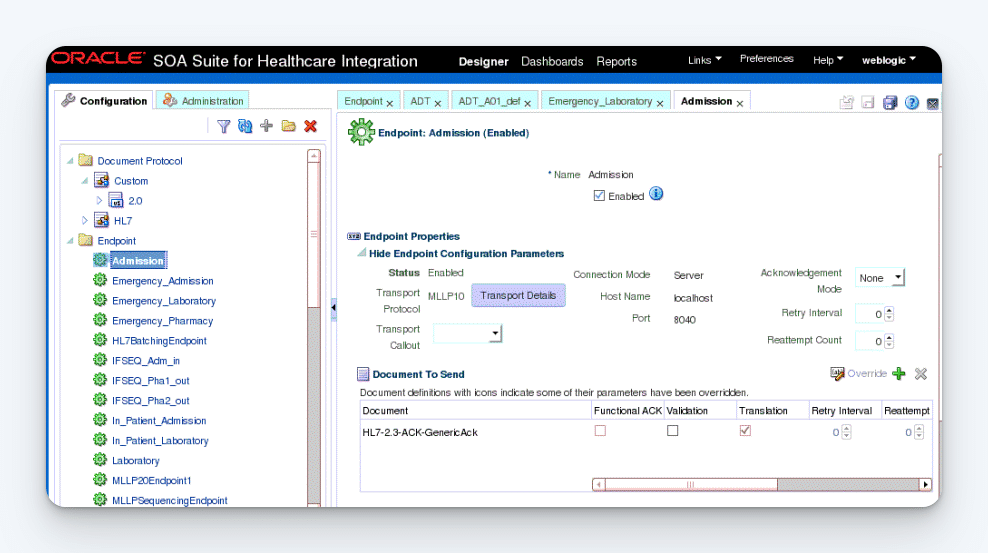
Oracle Health takes a broad view of workforce management, connecting time and attendance to the bigger picture of hospital operations. Instead of treating scheduling and payroll as separate tasks, Oracle weaves them into the same system that tracks patient demand, resource use, and clinical workflows. For large hospitals and health systems, that means staffing decisions are tied to the realities of patient care and organizational needs.
On the ground, the software makes scheduling more predictable and less reactive. Nurse managers can build shifts that reflect current patient volumes, with safeguards that ensure required staff-to-patient ratios are always met. If demand rises unexpectedly, the system flags coverage gaps so leaders can respond before care is compromised.
Staff benefit from mobile access that makes it easy to view schedules, swap shifts, or clock in and out without jumping through hoops.
For payroll, Oracle automates much of the complexity that comes with healthcare workforces. Differential pay for nights and weekends, union agreements, overtime calculations, and meal or break compliance are all built into the system. Timecards update automatically as schedules shift, which helps reduce errors and eliminates the scramble of manual adjustments after payroll closes.
What makes Oracle unique is how it unifies staffing data with the rest of the hospital ecosystem. Finance, HR, and clinical teams all work from the same source of truth, with dashboards that show where staffing costs are rising, where resources are stretched thin, and how labor decisions impact patient services. For leaders, that visibility supports smarter planning; for caregivers, it ensures that staffing is always aligned with the needs of the floor.
Key features
- Healthcare-specific staffing support — Designed for hospitals and large health systems, Oracle helps balance shift coverage across departments while ensuring safe staffing ratios.
- Smart scheduling tools — Builds balanced schedules that ensure required staffing levels, while flagging gaps when patient volumes rise unexpectedly.
- Compliance automation — Tracks overtime, differential pay, union agreements, and break rules automatically, reducing payroll errors and protecting against compliance risks.
- Mobile access for staff — Nurses, aides, and providers can view schedules, swap shifts, and clock in/out directly from their phones.
- Hospital-wide visibility — Real-time dashboards show labor costs, coverage levels, and staffing trends, helping leaders plan resources without compromising patient care.
Pricing
- Contact Oracle for a quote
8. Nursegrid – Best for nurses and nurse managers
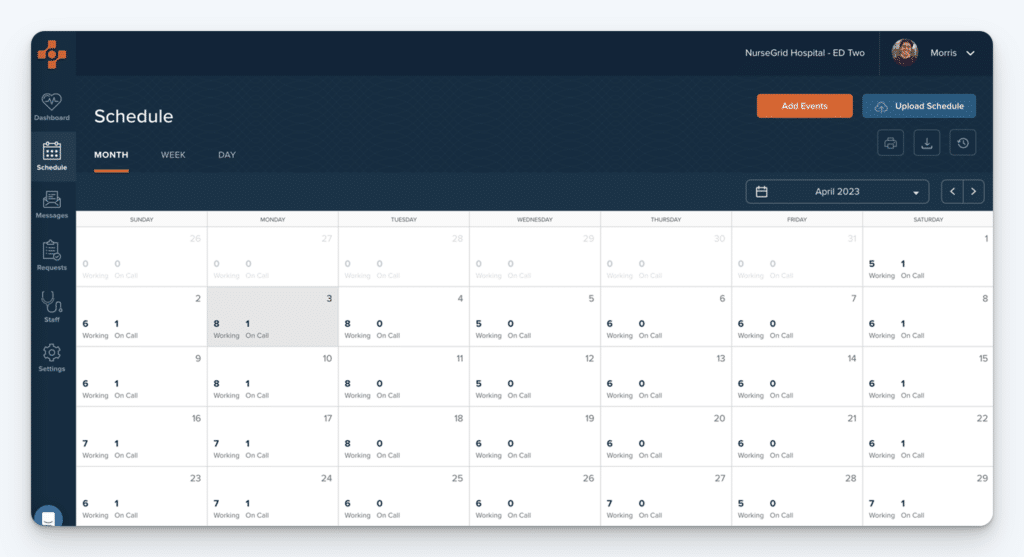
Unlike traditional workforce systems built for administrators, Nursegrid puts staff first, giving frontline caregivers more control and clarity over their schedules. The mobile app is simple, intuitive, and widely adopted in hospitals and clinics across the country.
With Nursegrid, it’s easy for nurses to check shifts, swap coverage, and stay connected with their teams. For managers, Nursegrid Manager turns what’s often a painful scheduling process into a straightforward task.
Instead of juggling spreadsheets or relying on endless group texts, administrators can build, publish, and adjust schedules in minutes. The platform is built to scale with departments, small practices, and clinical teams, making it especially well-suited for community hospitals, specialty clinics, and outpatient care centers.
Nursegrid balances professional scheduling tools with features that support career growth and engagement. Beyond shifts and attendance, the app helps nurses manage credentials and continuing education requirements, keeping compliance in check while supporting ongoing learning. That combination of workforce management and personal development makes Nursegrid both a time and attendance solution and a career companion.
For organizations that need an affordable, nurse-friendly system that boosts staff satisfaction while reducing scheduling headaches, Nursegrid offers an approachable option without the complexity of enterprise platforms.
Key features
- Nurse-first mobile app — Built for nurses to view schedules, see who they’re working with, swap shifts, and stay connected with colleagues.
- Fast scheduling tools — Managers can create and share schedules in minutes, with features to fill open shifts and approve swaps quickly.
- Team communication — Integrated messaging reduces reliance on group texts and helps keep staff aligned.
- Credential management — Nurses can track and manage license renewals and certifications directly in the app.
- Affordable pricing — Starts at just $5 per team member per month, with a 30-day free trial available.
Pricing
- $5 per user/month for Nursegrid Manager.
9. Smartlinx – Best for long-term care & post-acute facilities
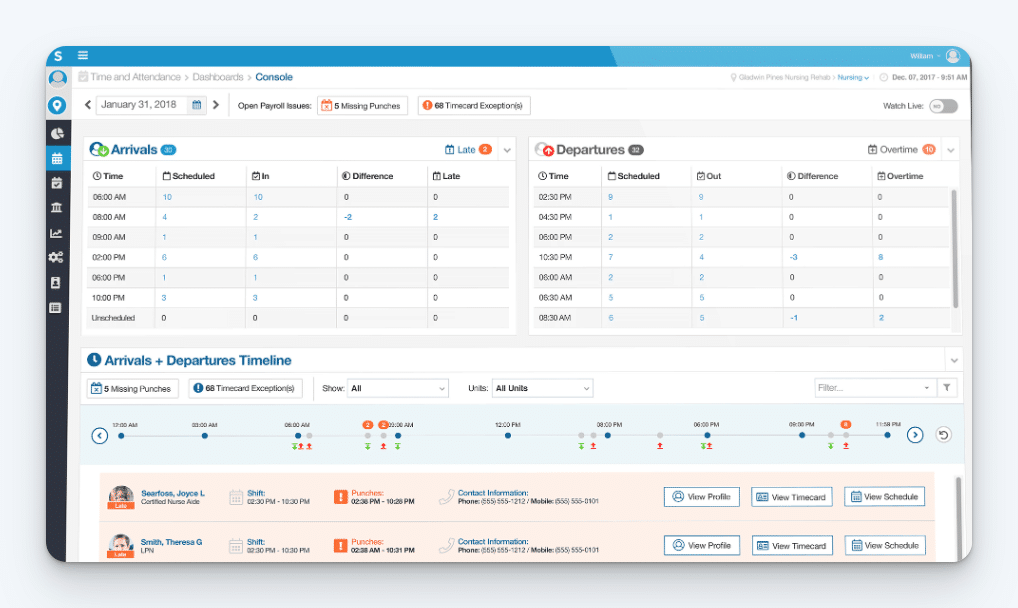
Long-term care and senior living facilities face unique staffing challenges: high turnover, regulatory scrutiny, and the constant need to balance quality care with tight budgets. Instead of piecing together separate systems for scheduling, timekeeping, and payroll, Smartlinx provides an all-in-one platform designed to keep caregivers where they’re needed most — at the bedside.
With its Schedule Optimizer, Smartlinx helps managers quickly build compliant schedules that match staffing levels to resident needs. The system automatically predicts and flags overtime risks, so leaders can fill gaps without driving up labor costs. Real-time updates and mobile tools make it easy to respond to call-outs or last-minute changes, keeping shifts covered without the usual scramble.
On the time and attendance side, Smartlinx delivers visibility into every punch, absence, and overtime hour across the workforce. Touchless and biometric time clocks, along with mobile punching, ensure accuracy and accountability while reducing the risk of buddy punching or time theft. For administrators, the integration between scheduling and timekeeping means payroll runs on clean, accurate data.
Smartlinx also puts tools directly into caregivers’ hands. Through the Smartlinx Go mobile app, employees can see their schedules, swap shifts, request time off, and even view pay information without needing to call HR. That transparency helps reduce turnover in an industry where retention is always a challenge.
For skilled nursing, assisted living, and post-acute care providers, Smartlinx offers a workforce solution that helps control costs, support compliance, and improve the daily lives of both staff and residents.
Key features
- Schedule Optimizer — Generates smart, compliant schedules in seconds, predicting and preventing costly overtime.
- Real-time timekeeping — Tracks punches, absences, and overtime as they happen, with tools to edit and approve requests on the fly.
- Integrated compliance support — Helps meet the Centers for Medicare and Medicaid Services staffing standards and other regulatory requirements with accurate reporting.
- Smartlinx Go mobile app — Empowers caregivers to swap shifts, request time off, and access schedules and pay data from anywhere.
- Time theft prevention — Uses touchless and biometric time clocks, plus location-based rules, to ensure accurate attendance.
- Workforce analytics — Provides actionable insights into turnover, overtime, and staffing levels, with tools like the Five-Star Predictor to track performance against federal benchmarks.
Pricing
- Contact Smartlinx sales for a quote.
Choosing the best time and attendance software for your healthcare organization
Every healthcare team has the same goal: safe, reliable, patient-centered care. But the path to get there looks different for a small private practice than it does for a large hospital system. That’s why the “best” time and attendance software is the one that matches your size, complexity, and staffing challenges.
For independent practices and specialty clinics, simplicity is often the priority. A tool like Buddy Punch offers exactly that. It boasts easy scheduling, accurate time tracking, and seamless payroll integrations. That way, you can keep operations running smoothly without extra administrative burden.
For larger facilities — where dozens or even hundreds of providers must be scheduled across multiple departments — platforms like QGenda, Symplr, or Smartlinx provide the scale and compliance features needed to manage complex staffing rules while keeping labor costs under control.
And for organizations focused on staff engagement and retention, apps like Nursegrid, Vagaro, or Mindbody can give frontline staff more visibility and control over their schedules, which can go a long way in reducing burnout and turnover.
The best way to choose is to start with your biggest pain point. If payroll errors are your main frustration, look for strong integrations and automated pay rules. If constant call-outs are disrupting care, prioritize scheduling tools with real-time alerts and easy shift swaps. And if turnover is your challenge, consider solutions with mobile apps that empower staff to manage their own schedules.
At the end of the day, the right software helps you build a system that supports your caregivers and, by extension, your patients.